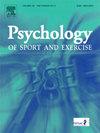Cognitive dual-task does not annihilate the negative effects of gender stereotype threat on girls' motor learning
IF 3.1
2区 心理学
Q2 HOSPITALITY, LEISURE, SPORT & TOURISM
引用次数: 0
Abstract
Stereotype threat, a key concept in social psychology, occurs when individuals fear they may confirm negative stereotypes about their social group (Steele, 1997). This phenomenon can significantly impair motor learning, particularly in children. Given the robust nature of stereotype threat, research it is now focused on mitigating these negative effects. According to the explicit monitoring hypothesis, it is suggested that distracting individual’s attention can lead to an annihilation of stereotype threat effects, however, to date, this hypothesis has not been examined in children. The present study examined the effect of stereotype threat in a dual task condition on children’s motor learning. One hundred and fifty girls (mean age = 10.96 ± .80 years) were randomly assigned into 3 groups; 1- explicit gender stereotype threat; 2- explicit gender stereotype threat + dual task; 3- control. The task consisted of a soccer-kicking task in which the participants had to score the most points by kicking the soccer ball towards the goals on the wall. This study included three phases; 1- pretest (10 trials); 2- practice phase (5 blocks of 10 trials); 3- retention test (10 trials). During the practice phase, the results indicated that participants in the control condition performed better (M = 1.46, SD = .19) than participants in the gender stereotype threat condition (M = 1.25, SD = .16, p < .001), and, than participants in the gender stereotype threat + dual task paradigm condition (M = .92, SD = .19, p < .001). However, participants in the gender stereotypes + dual task paradigm condition performed worse than participants in the gender stereotype threat condition (p < .001). In addition, the results of the retention test showed that participants in the control condition performed better (M = 1.51, SD = .34) than participants in the gender stereotype threat condition (M = 1.24, SD = .35, p = .001), and participants in the gender stereotype threat + dual task paradigm condition (M = 1.15, SD = .49, p < .001). In conclusion, these results do not support the potential neutralizing effect of a cognitive dual task in a stereotype threat condition in children.
认知双重任务并不能消除性别刻板印象威胁对女孩运动学习的负面影响。
刻板印象威胁是社会心理学中的一个重要概念,当个人担心自己会证实对其社会群体的负面刻板印象时,就会产生刻板印象威胁(Steele,1997 年)。这种现象会严重影响运动学习,尤其是儿童的运动学习。鉴于刻板印象威胁的强大性质,目前的研究重点是减轻这些负面影响。根据显性监控假说,分散个人注意力可消除刻板印象威胁效应,但迄今为止,这一假说尚未在儿童身上得到验证。本研究考察了在双重任务条件下刻板印象威胁对儿童运动学习的影响。150名女孩(平均年龄为10.96 ± .80岁)被随机分配到3个小组:1-明确的性别刻板印象威胁组;2-明确的性别刻板印象威胁+双重任务组;3-对照组。任务包括踢足球,参与者必须将足球踢向墙上的球门,以获得最多分数。这项研究包括三个阶段:1- 前测(10 次试验);2- 练习阶段(5 组,每组 10 次试验);3- 保持测试(10 次试验)。结果显示,在练习阶段,对照组条件下的参与者(M = 1.46,SD = .19)比性别刻板印象威胁组条件下的参与者(M = 1.25,SD = .16,P<0.05)表现更好。
本文章由计算机程序翻译,如有差异,请以英文原文为准。
求助全文
约1分钟内获得全文
求助全文
来源期刊
CiteScore
6.40
自引率
5.90%
发文量
172
审稿时长
69 days
期刊介绍:
Psychology of Sport and Exercise is an international forum for scholarly reports in the psychology of sport and exercise, broadly defined. The journal is open to the use of diverse methodological approaches. Manuscripts that will be considered for publication will present results from high quality empirical research, systematic reviews, meta-analyses, commentaries concerning already published PSE papers or topics of general interest for PSE readers, protocol papers for trials, and reports of professional practice (which will need to demonstrate academic rigour and go beyond mere description). The CONSORT guidelines consort-statement need to be followed for protocol papers for trials; authors should present a flow diagramme and attach with their cover letter the CONSORT checklist. For meta-analysis, the PRISMA prisma-statement guidelines should be followed; authors should present a flow diagramme and attach with their cover letter the PRISMA checklist. For systematic reviews it is recommended that the PRISMA guidelines are followed, although it is not compulsory. Authors interested in submitting replications of published studies need to contact the Editors-in-Chief before they start their replication. We are not interested in manuscripts that aim to test the psychometric properties of an existing scale from English to another language, unless new validation methods are used which address previously unanswered research questions.

 求助内容:
求助内容: 应助结果提醒方式:
应助结果提醒方式:


